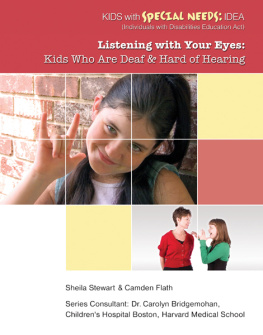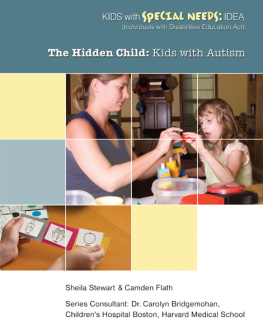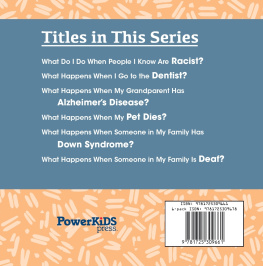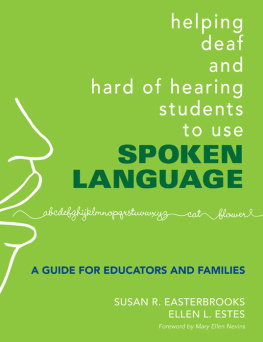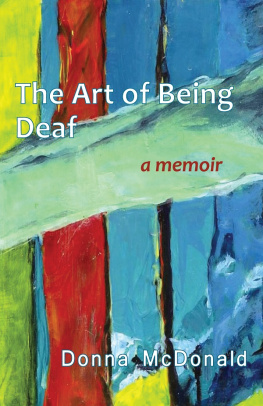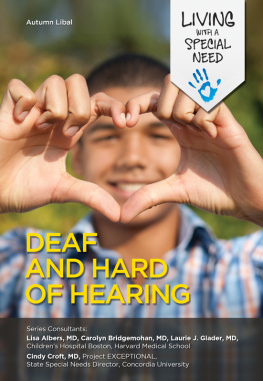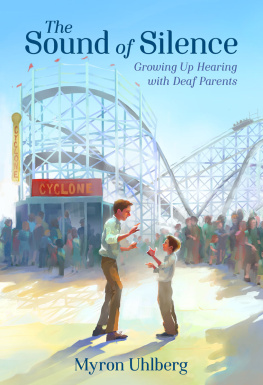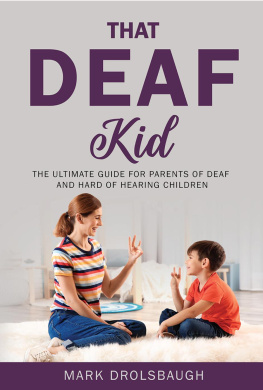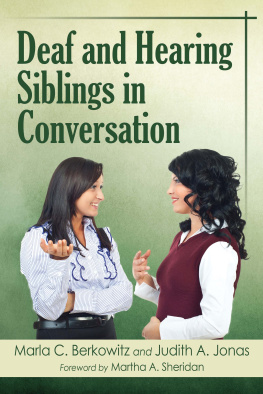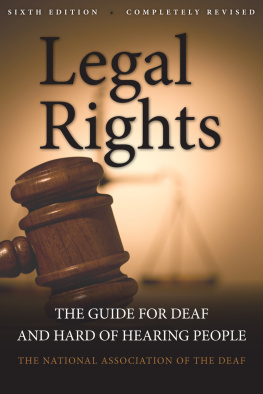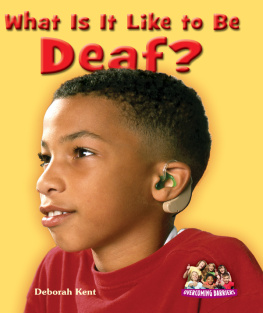Listening with Your Eyes
Kids Who Are Deaf and Hard of Hearing
Kids with Special Needs
Seeing with Your Fingers: Kids with Blindness and Visual Impairment
Listening with Your Eyes: Kids Who Are Deaf and Hard of Hearing
My Name Is Not Slow: Kids with Intellectual Disabilities
Sick All the Time: Kids with Chronic Illness
Somethings Wrong! Kids with Emotional Disturbance
Speed Racer: Kids with Attention-Deficit/Hyperactivity Disorder
Finding My Voice: Kids with Speech Impairment
I Can Do It! Kids with Physical Challenges
The Hidden Child: Kids with Autism
Whats Wrong with My Brain? Kids with Brain Injury
Why Cant I Learn Like Everyone Else? Kids with Learning Disabilities
Listening with Your Eyes
Kids Who Are Deaf and Hard of Hearing
by Sheila Stewart and Camden Flath
Copyright 2011 by Mason Crest Publishers. All rights reserved. No part of this publication may be reproduced or transmitted in any form or by any means, electronic or mechanical, including photocopying, recording, taping, or any information storage and retrieval system, without permission from the publisher.
MASON CREST PUBLISHERS INC.
370 Reed Road
Broomall, Pennsylvania 19008
(866)MCP-BOOK (toll free)
www.masoncrest.com
First Printing
9 8 7 6 5 4 3 2 1
ISBN (set) 978-1-4222-1727-6 ISBN (pbk set) 978-1-4222-1918-8
Library of Congress Cataloging-in-Publication Data
Stewart, Sheila, 1975
Listening with your eyes: kids who are deaf and hard of hearing / by Sheila Stewart and Camden Flath.
p. cm.
ISBN 978-1-4222-1717-7 ISBN (pbk) 978-1-4222-1920-1
1. Deaf childrenJuvenile literature. 2. Deafness in childrenJuvenile literature. 3. Hearing impaired childrenJuvenile literature. I. Flath, Camden, 1987 II. Title.
HV2392.S74 2010
362.42083dc22
2010004979
Produced by Harding House Publishing Service, Inc.
www.hardinghousepages.com
Design by MK Bassett-Harvey.
Cover design by Torque Advertising Design.
Printed in the USA by Bang Printing.
Photo Credits
Creative Commons Attribution 2.0 Generic/Unported: Camazine: pg. 34, mricon: pg. 37; GNU Free Documentation License, Version 1.2; morgueFile: jdurham: pg. 38, taliesin: pg. 31; United States Air Force; United States Army; Ford, Kyle: pg. 40
The creators of this book have made every effort to provide accurate information, but it should not be used as a substitute for the help and services of trained professionals.
Introduction
To the Teacher
Kids with Special Needs provides a unique forum for demystifying a wide variety of childhood medical and developmental disabilities. Written to captivate an elementary-level audience, the books bring to life the challenges and triumphs experienced by children with common chronic conditions such as hearing loss, intellectual disability, physical differences, and speech difficulties. The topics are addressed frankly through a blend of fiction and fact.
This series is particularly important today as the number of children with special needs is on the rise. Over the last two decades, advances in pediatric medical techniques have allowed children who have chronic illnesses and disabilities to live longer, more functional lives. At the same time, IDEA, a federal law, guarantees their rights to equal educational opportunities. As a result, these children represent an increasingly visible part of North American population in all aspects of daily life. Students are exposed to peers with special needs in their classrooms, through extracurricular activities, and in the community. Often, young people have misperceptions and unanswered questions about a childs disabilitiesand more important, his or her abilities. Many times, there is no vehicle for talking about these complex issues in a comfortable manner.
This series will encourage further conversation about these issues. Most important, the series promotes a greater comfort for its readers as they live, play, and study side by side with these children who have medical and developmental differenceskids with special needs.
Dr. Carolyn Bridgemohan
Boston Pediatric Hospital/Harvard Medical School

Abby stared out of the window of the school bus, watching the rain fall. Trees, houses, and people went by outside.
Inside the bus, even without looking at them, Abby could tell the other kids were excited about the first day of school. From the corner of her eye, she could see kids bouncing in their seats, and every once in a while someone hit the back of her seat. She knew they must be loud, because when she looked she could see the bus drivers mouth opening wide, like he was yelling.
She wondered what her teacher would be like this year. Ms. Doyle was new so no one knew anything about her. Sometimes teachers acted annoyed that she had a sign language interpreter or that she needed copies of the class notes or even sometimes just that she couldnt hear. Fifth grade was an important year; a bad teacher could ruin everything.
The bus stopped and the kids got louder. She could see their noise in their energy. She felt like she could almost feel the noise prickling on her skin. But she couldnt hear anything. If she closed her eyes, she might as well have been alone.
Brennan, her interpreter, was waiting for her in the classroom at a table near the teachers desk, although it was off to one side so his interpreting didnt distract the other kids. She kind of had a crush on Brennan, but he and his wife had just had a baby girl, so she supposed she couldnt marry him after all.

Hey Abby! Brennan said, speaking the words with his lips and signing at the same time. How was your summer? How was camp?
Great! she signed.
Every summer she spent a week at a camp for kids who were deaf and hard of hearing. She loved getting to be at place where she was just like everyone else for a change. She started to tell Brennan more about it, but he stopped her.
Say the words while you sign.
She didnt like talking in class, because she could never tell how loud her voice was, but she started again, telling Brennan about her summer.
The class had mostly filled up while she was talking to Brennan. A woman was standing behind the teachers desk, looking at a laptop. The woman was not old, but not really young, either. She wore a blue flowered dress and had bright red hair. She turned around and wrote Ms. Doyle on the white board in big curly letters.
Ms. Doyle turned out to be a pretty good teacher. She kept her head turned toward Abby when she talked, so that Abby could work on lip reading. Abby wasnt always very good at lip reading, but her parents and her speech therapist kept telling her to practice more.
Ms. Doyle also gave Abby handouts of the class notes at the end of each day. She never seemed bothered by doing this, and she didnt seem to mind Brennan either, so she immediately became Abbys favorite teacher ever.
Mostly, nobody in class tried to talk to Abby. Sometimes people smiled at her. If they did have to say something, they usually talked with big, exaggerated lip movements that were impossible to understand.
During the third week of school, Abby looked up during lunch and saw the girlshe thought her name was Madisonsay the word party.
Next page
